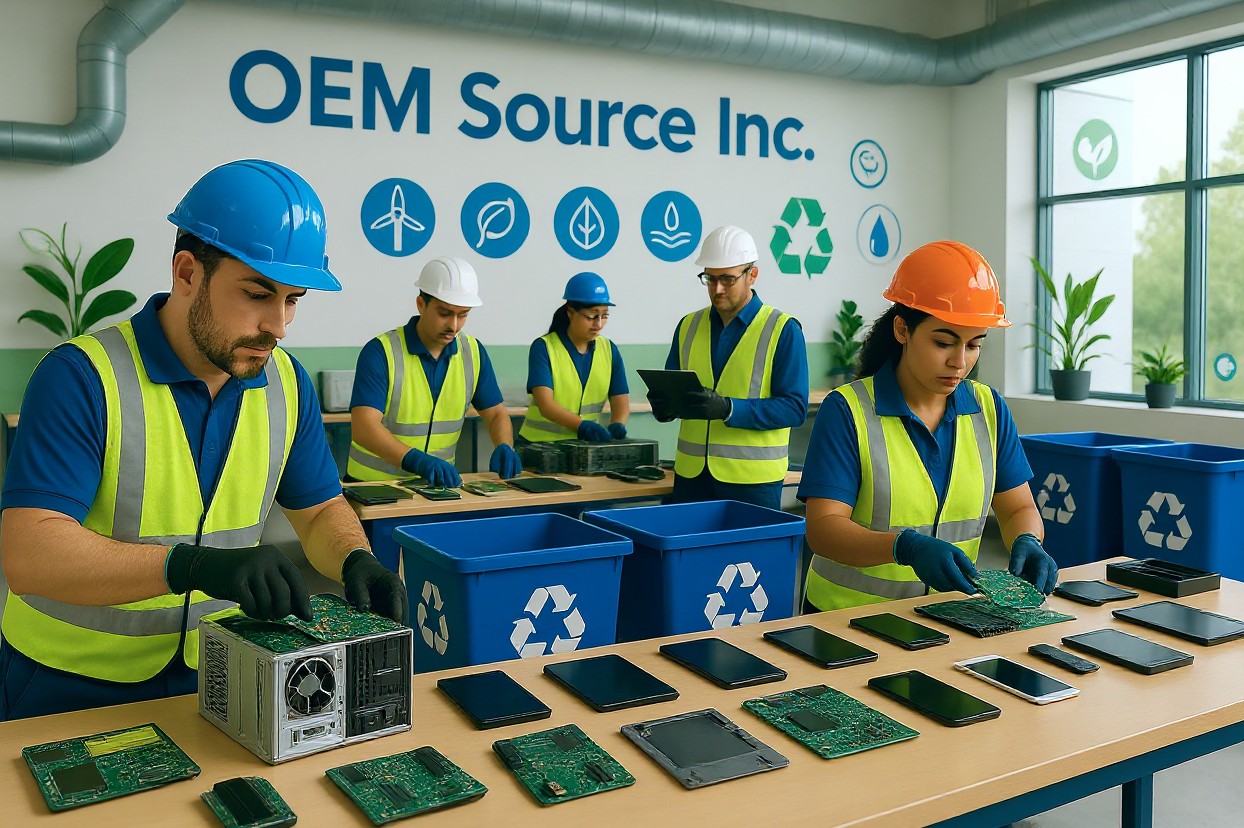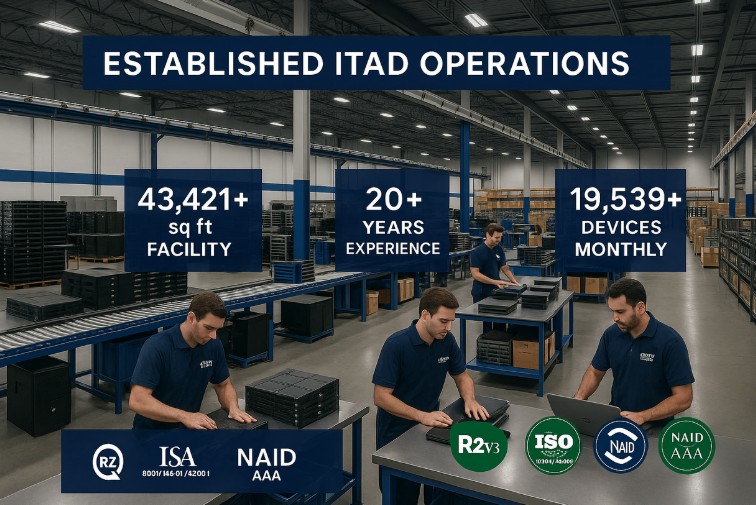The smartphone in your pocket contains more computing power than the computers that sent humans to the moon, yet its lifespan averages just 2.5 years before it’s replaced. Multiply this by the billions of electronic devices manufactured annually, and the scale of the electronic waste (e-waste) crisis becomes clear. Once obsolete, these devices enter the fastest-growing waste stream on the planet—one that threatens our ecosystem while also offering new opportunities for resource recovery, environmental stewardship, and economic growth.
Global e-waste generation has reached alarming levels. According to the U.N.’s Global E-waste Monitor, discarded electronic products will reach 74 million tonnes by 2030, nearly doubling in just 16 years. Yet despite this growing crisis, only 20% of global e-waste is currently recycled. The rest ends up in landfills or incinerators, wasting recoverable materials and leaching hazardous substances into soil and groundwater.
The Growing Challenge of E-Waste
The exponential rise in e-waste represents one of the most urgent environmental and infrastructure challenges of the digital era. As digital transformation accelerates and consumer electronics become indispensable to daily life, the volume and complexity of discarded electronic devices continue to rise at unprecedented rates. This equally places pressure on existing recycling systems, supply chains, and sustainability programs.
What Is E-Waste?
E-waste refers to discarded electrical and electronic equipment (EEE) that has reached the end of its useful life or become obsolete due to rapid technological advancements. It spans both household and industrial categories, including:
- Consumer Electronics – Smartphones, tablets, laptops, desktop computers, and gaming consoles
- Home Appliances – Televisions, refrigerators, washing machines, and microwave ovens
- Office Equipment – Printers, copiers, fax machines, and telecommunications systems
- Industrial Electronics – Manufacturing equipment, medical devices, and scientific instruments
- Components and Accessories – Circuit boards, batteries, cables, and power supplies
- Emerging Technologies – IoT devices, smart home systems, and wearable technology
E-Waste Statistics: A Growing Global Challenge
The scale of global e-waste generation underscores the urgency of action and the accelerating impact on ecosystems. According to recent monitoring efforts, e-waste is growing at a compound annual growth rate of approximately 30% far outpacing traditional waste streams and the development of global recycling infrastructure.
India alone generates about 2 million tonnes of e-waste annually, with projections showing steep increases. The ASSOCHAM trade association estimated India’s e-waste output at 1.8 million tonnes in 2016, and predicted it would reach 5.2 million tonnes per year by 2022. These figures reflect broader global trends as electronic devices become more pervasive and shorter-lived.
Why E-Waste Is Increasing
Several interconnected factors are driving the sharp rise in e-waste:
- Planned Obsolescence – Many electronics are designed with short lifespans or limited upgradability
- Rapid Innovation Cycles – Frequent tech upgrades push consumers to replace devices sooner
- Falling Costs and Greater Accessibility – Electronics are more affordable and widely available worldwide
- Increased Connectivity – The rise of IoT devices, smart homes, and mobile computing has expanded the number of electronics in circulation
These dynamics, combined with a lack of global recycling infrastructure, are fueling the exponential growth of electronic waste.
Environmental Benefits of E-Waste Recycling
Proper e-waste recycling offers far-reaching environmental and economic advantages, including resource conservation, pollution prevention, and support for circular economy initiatives.
Reduction of Landfill Waste
E-waste recycling prevents tons of non-biodegradable electronics from ending up in landfills, where they would persist for decades or longer. Critically, it also helps:
- Preventing the leaching of hazardous materials such as lead, mercury, cadmium, and brominated flame retardants
- Protect groundwater and soil health by containing and properly managing toxic components
Reduce the need for landfill expansion, which contributes to land degradation and emissions
Conservation of Valuable Natural Resources
Electronics are rich in precious metals and critical minerals, including gold, copper, palladium, and rare earth elements. Recycling these materials reduces dependence on environmentally damaging mining operations.
However, current recovery rates remain low. The UN reports that only 30% of cobalt, a key component in laptops, smartphones, and electric vehicle batteries, is recovered from e-waste. Improving these recovery processes is essential to meet the rising demand for sustainable technology development.
Prevention of Toxic Pollution
Unlike informal or unsafe disposal methods, professional e-waste recyclers use specialized equipment to contain and neutralize toxic substances. This helps:
- Prevent toxic air emissions caused by open burning or improper incineration
- Protect waterways and aquatic ecosystems from heavy metal contamination
- Safeguard human health, particularly in communities near unregulated e-waste dumping sites
Supporting the Shift to Green Technologies
E-waste recycling provides secondary sources of materials essential to green technologies, including:
- Renewable energy systems (e.g., wind turbines, solar panels)
- Energy-efficient electronics and appliances
- Clean transportation (e.g., electric vehicle batteries)
Economic Benefits of E-Waste Recycling
The economic impact of e-waste recycling extends far beyond waste management, creating substantial value through job creation, economic growth, and sustainable business models.
Contribution to Job Creation
According to the EPA, recycling and reusing e-waste accounts for over 681,000 jobs in a single year, spanning diverse roles including:
- Collection and Logistics – Drivers, warehouse workers, and logistics coordinators
- Processing and Dismantling – Technicians, equipment operators, and quality control specialists
- Refurbishment and Repair – Electronics technicians, testing specialists, and quality assurance personnel
- Materials Recovery – Chemical processing technicians, metallurgists, and materials scientists
- Sales and Distribution – Account managers, customer service representatives, and market analysts
Promotion of Economic Growth
E-waste recycling contributes to economic growth through direct economic activity, recycling-based supply chain development, and innovation in material recovery technologies. The economic value of materials contained in e-waste represents substantial untapped potential, with precious metals and rare earth elements worth billions of dollars annually.
Support for a Circular Economy
E-waste recycling exemplifies circular economy principles by keeping materials in productive use, extracting maximum value before recovery and regeneration. This approach supports closed-loop systems that minimize waste while generating new business opportunities and revenue streams.
Challenges in E-Waste Recycling
Despite the significant benefits of e-waste recycling, the industry faces numerous challenges that limit its effectiveness and scalability, spanning technical, logistical, regulatory, and economic dimensions.
Complex Logistics and Infrastructure Issues
E-waste recycling requires sophisticated logistics networks and specialized infrastructure capable of handling the collection, transportation, and processing of diverse electronic devices safely and efficiently. Many regions lack adequate e-waste collection infrastructure, resulting in improper disposal and lost opportunities for material recovery.
Health and Safety Concerns
E-waste processing involves exposure to hazardous materials and toxic substances that pose significant health and safety risks to workers and surrounding communities. The complexity of modern electronic devices creates additional safety challenges, requiring extensive training, specialized equipment, and ongoing occupational safety monitoring.
Risks of Illegal Dumping
Inadequate e-waste management infrastructure and limited enforcement of environmental regulations create opportunities for illegal dumping and improper disposal of electronic waste. These practices pose significant environmental and health risks while undermining legitimate recycling efforts.
Regulatory and Compliance Measures
Effective e-waste management requires comprehensive regulatory frameworks that establish clear standards, responsibilities, and enforcement mechanisms for all stakeholders in the electronics lifecycle.
Importance of Robust Regulations
Regulatory frameworks play a crucial role in establishing minimum standards for e-waste management and defining responsibilities for manufacturers, retailers, and consumers. Extended Producer Responsibility (EPR) regulations require producers to collect between 30% and 70% of the e-waste they generate over a seven-year period, creating incentives for sustainable product design and disposal practices.
Role of Compliance in E-Waste Recycling
Compliance with environmental regulations and industry standards ensures that e-waste recycling operations meet minimum requirements for environmental protection, worker safety, and data security. Certification programs such as R2v3 provide structured frameworks for responsible recycling practices while promoting accountability and transparency throughout the recycling process.
Ensuring Data Security through Recycling
Data security represents a critical component of responsible e-waste recycling, as electronic devices often contain sensitive or proprietary information that must be properly destroyed. Organizations seeking secure data destruction should work with providers offering NAID AAA-certified destruction methods to ensure full data sanitation and compliance with privacy regulations.
Strategies for Effective E-Waste Management
Successful e-waste management requires strategic approaches that address collection, processing, and disposal challenges while maximizing environmental and economic outcomes.
Choosing Certified Recyclers
Selecting certified e-waste recyclers ensures that devices are processed according to stringent environmental, safety, and security standards. Key evaluation criteria include:
- Certification Status – R2v3, ISO 14001, and other relevant certifications
- Data Security Capabilities – NAID AAA certification and secure destruction processes
- Environmental Compliance – Proper handling of hazardous materials and regulated waste
- Transparency and Reporting – Detailed documentation, reporting, and audit trails
- Processing Capabilities – Specialized equipment and facilities suitable for device types
- Downstream Management – Responsible handling of components and recovered material
Promoting Product Lifecycle Management
Product lifecycle management integrates e-waste considerations into product design, manufacturing, and marketing strategies. This includes:
- Design for disassembly
- Material selection for recyclability
- Manufacturer take-back or trade-in programs
- Extended durability and upgradeability features
These strategies help reduce e-waste generation at the source while supporting more circular business models.
Educating Businesses on Sustainable Practices
Education and awareness initiatives equip businesses with the knowledge needed to adopt responsible e-waste management practices. Programs should cover:
- Regulatory compliance requirements
- Data security requirements and destruction best practices
- Cost-benefit analysis of sustainable disposal options
- Vendor selection criteria for certified recyclers
Providing practical, actionable guidance helps organizations implement meaningful change across IT asset management and sustainability efforts.
Enhancing Corporate Social Responsibility (CSR)
E-waste recycling provides a valuable opportunity for organizations to demonstrate environmental leadership while creating business value through improved brand reputation and stakeholder engagement.
Benefits of Sustainable Practices for Brand Reputation
Organizations that implement comprehensive e-waste recycling programs demonstrate a clear commitment to environmental responsibility and sustainability. These practices enhance brand reputation by:
- Environmental Leadership – Demonstrating a proactive approach to sustainability and resource conservation
- Transparency and Accountability – Providing clear documentation and reporting of environmental efforts and impact
- Stakeholder Engagement – Encouraging participation from customers, employees, and partners in sustainability initiatives
- Regulatory Compliance – Meeting or exceeding environmental regulations and industry standards
- Innovation and Efficiency – Driving process improvements through waste reduction and resource optimization
- Community Impact – Supporting local economies and environmental stewardship through responsible recycling
Integration of E-Waste Recycling in Business Strategy
Strategically integrating e-waste recycling into business operations allows organizations to align sustainability goals with operational objectives. For organizations seeking comprehensive solutions, OEM Source offers e-Waste recycling services with R2v3-certified processing to ensure environmental compliance, maximal material recovery, and data security.
The Future of E-Waste Recycling
The future of e-waste recycling will be shaped by technological innovations, regulatory developments, and evolving business models that address current challenges while creating new opportunities.
Emerging Trends in E-Waste Management
Key trends include automated processing technologies, artificial intelligence integration for material identification, and blockchain-based tracking systems for greater supply chain transparency. The growth of IoT devices is also creating new categories of e-waste that require specialized handling approaches.
Innovations in Recycling Technologies
Advanced sorting technologies, automated disassembly systems, and improved material recovery processes are increasing the value and volume of materials recovered from electronic waste—while also reducing costs and environmental impact.
Role in Sustainable Development Goals
E-waste recycling supports multiple United Nations Sustainable Development Goals (SDGs), including responsible consumption and production, climate action, and sustainable cities and communities.
For organizations managing comprehensive IT asset lifecycles, OEM Source’s R2v3-certified IT asset disposition services provide secure data destruction, environmental compliance, and value recovery—delivering reliable, audit-ready solutions for enterprise sustainability initiatives.
Frequently Asked Questions
What are the benefits of recycling electronics?
Recycling electronics provides numerous environmental and economic benefits, including conservation of natural resources, reduction of landfill waste, prevention of toxic pollution, and creation of employment opportunities. According to the EPA, e-waste recycling accounts for more than 681,000 jobs annually while recovering valuable materials such as precious metals and rare earth elements.
How does recycling help with sustainability?
E-waste recycling supports sustainability by keeping valuable materials in productive use, reducing the need for virgin resource extraction, and minimizing environmental impact throughout the electronics lifecycle. It helps cut greenhouse gas emissions, conserves energy, and prevents environmental contamination caused by improper disposal.
Is it worth recycling electronics?
Yes, recycling electronics is highly worthwhile from both environmental and economic perspectives. The valuable materials contained in electronic devices represent significant economic value when properly recovered, while environmental benefits include the prevention of toxic contamination and the conservation of natural resources.
What are the advantages and disadvantages of recycling e-waste?
Advantages include environmental protection, job creation, resource conservation, and alignment with sustainable development goals. Disadvantages may involve infrastructure complexity, health and safety risks, and challenges related to illegal dumping. However, when managed responsibly, the benefits far outweigh the drawbacks.
How can businesses ensure responsible e-waste recycling?
Businesses can ensure responsible recycling by partnering with certified recyclers that follow environmental and data security standards. Look for certifications such as R2v3 or ISO 14001, and confirm the recycler provides proper documentation, secure data destruction, and compliant downstream handling of materials.





